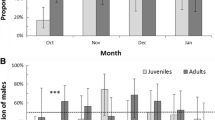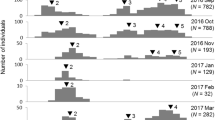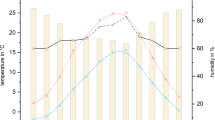Abstract
Mexico has the largest number of leporid species in the world but most have been little studied. The endemic Mexican cottontailSylvilagus cunicularius (Waterhouse, 1848) is the largest Mexican rabbit, and although not in danger of extinction, it is increasingly threatened. Since little is known about its annual pattern of reproduction, we studied this species in La Malinche National Park, central Mexico, whereS. cunicularius is still common. For 7 years we trapped and marked 157 different individuals (plus 59, sometimes multiple, re-captures), determining across the year the percent of adult females that were reproductively active, the number of juveniles as a percent of total captures, and the percent of males with scrotal testes. Reproductively active females were present throughout the year but with a notable peak from March to October, juveniles were present throughout the year but with a peak from September to December, and adult males had scrotal testes throughout the year with no seasonal change in testis length. Onset of the breeding season coincided with increasing day length and temperature, and births with high rainfall. Thus, in central MexicoS. cunicularius breeds throughout the year but particularly during the warmer, wetter summer months. We therefore recommend that hunting only be permitted from November to February.
Similar content being viewed by others
References
Andersson M., Meurling P. and Dahlbäck M. 1979. Biology of the wild rabbit,Oryctolagus cuniculus, in southern Sweden. I. Breeding season. Swedish Wildlife Research (Viltrevy) 11: 101–127.
Animal Care and Use Committee. 1998. Guidelines for the capture, handling, and care of mammals as approved by the American Society of Mammalogists. Journal of Mammalogy 79: 1416–1431.
Aranda J. M., Martínez del Rio C., Colmenero L. C. and Magallon V. M. 1980. Los mamíferos de la sierra del Ajusco. Comisión Coordinadora para el Desarrollo Agropecuario, Departamento del Distrito Federal, Ciudad de México: 57–61.
Armstrong D. M. and Jones J. K. Jr. 1971. Mammals from the Mexican state of Sinaloa. I. Marsupialia, Insectivora, Edentata, Lagomorpha. Journal of Mammalogy 52: 747–757.
Blanco S., Ceballos G., Galindo C., Maass M., Patrón R., Pescador A. and Suárez A. 1981. Ecología de la Estación Experimental Zoquiapan: descripción general, vegetación y fauna. Cuadernos Universitarios 2. Universidad Autónoma de Chapingo, México D. F.: 1–115.
Boyd I. L. 1986. Photoperiodic regulation of seasonal testicular regression in the wild European rabbit (Oryctolagus cuniculus). Journal of Reproduction and Fertility 77: 463–470.
Boyd I. L. and Myhill D. G. 1987. Seasonal changes in condition, reproduction and fecundity in the wild European rabbit (Oryctolagus cuniculus). Journal of Zoology, London 212: 223–233.
Bronson F. M. 1989. Mammalian reproductive biology. The University of Chicago Press, Chicago and London: 1–325.
Ceballos G. C. and Galindo L. 1984. Mamíferos silvestres de la Cuenca de México. Limusa, México D.F: 1–299.
Ceballos G. and Miranda A. 1986. Los mamíferos de Chamela, Jalisco. Instituto de Biología, Universidad Nacional Autónoma de México, México D. F.: 202–207.
Cervantes F. A. 1993 Conejos y liebres de México. Ciencia y Desarrollo 110: 58–69.
Cervantes F. A., Delgado P. and Colmenares A. L. 2005.Sylvilagus cunicularius (Waterhouse, 1848). [In: Los mamíferos silvestres de México. G. Ceballos and G. Oliva, eds]. Comisión Nacional para el Conocimiento y Uso de la Biodiversidad and Fondo de Cultura Económica. México D. F.: 842–843.
Cervantes F. A., Lorenzo C., Vargas J. and Holmes T. 1992.Sylvilagus cunicularius. Mammalian Species 412: 1–4.
Cervantes-Reza F. A. 1982. Observaciones sobre la reproduccíon del Zacatuche o TeporingoRomerolagus diazi (Mammalia: Lagomorpha). Doñana-Acta Vertebrata 9: 416–420.
Chapman J. A. and Harman A. L. 1972. The breeding biology of a brush rabbit population. The Journal of Wildlife Management 36: 816–823.
Davis W. B. 1944. Notes on Mexican mammals. Journal of Mammalogy 25: 370–403.
Davis W. B. and Lukens P. W. Jr 1958. Mammals of the Mexican state of Guerrero, exclusive of Chiroptera and Rodentia. Journal of Mammalogy 39: 347–367.
Davis W. B. and Russell R. J. 1954. Mammals of the Mexican state of Morelos. Journal of Mammology 35: 63–80.
Diersing V. E. and Wilson D. E. 1980. Distribution and systematics of the rabbits (Sylvilagus) of west-central Mexico. Smithsonian Contributions to Zoology 297: 1–34.
Ecke D. H. 1955. The reproductive cycle of the Mearns cottontail in Illinois. American Midland Naturalist 53: 294–311.
Goncalves H., Alves P. C. and Rocha A. 2002. Seasonal variation in the reproductive activity of the wild rabbit (Oryctolagus cuniculus) in a Mediterranean ecosystem. Wildlife Research 29: 165–173.
González J., Lara C., Vázquez J. and Martínez-Gómez M. 2007. Demography, density, and survival of an endemic and near threatened cottontailSylvilagus cunicularius in central Mexico. Acta Theriologica 52: 299–305.
Hackländer K., Miedler S., Beiglböck C. and Zenker W. 2003. The assessment of female reproduction and gestational age in European hares (Lepus europaeus) using ultrasonography. Mammalian Biology 68: 187–181.
Hall E. R. 1981. The Mammals of North America. Vol. 1. Ronald Press, New York: 1–1271.
Hoffmann R. S. and Smith A. T. 2005. Order Lagomorpha. [In: Mammal species of the world: a taxonomic and geographic reference. Third Edition. D. E. Wilson and D. M. Reeder, eds]. The Johns Hopkins University Press, Baltimore: 185–211.
Hudson R. and Distel H. 1990. Sensitivity of female rabbits to changes in photoperiod as measured by pheromone emission. Journal of Comparative Physiology A 167: 225–230.
Hudson R., Rodríguez-Martínez L., Distel H., Cordero C., Altbäcker V. and Martínez-Gómez M. 2005. A comparison between vegetation and diet records from the wet and dry seasons in the cottontail rabbitSylvilagus floridanus at Ixtacuixtla, central Mexico. Acta Theriologica 50: 377–389.
IUCN 2006. Red list of threatened species. www.iucnredlist.org. Downloaded 28 December 2006.
Monroy-Vilchis O., Rangel-Cordero H., Aranda M., Velázquez A. and Romero F. J. 1999. Los mamíferos de hábitat templado del sur de la Cuenca de México. [In: Biodiversidad de la región de montańa del sur de la Cuenca de México: bases para el ordenamiento ecológico. A. Velázquez and F. J. Romero, eds]. UNAM-X-SEMARNAP. México D. F: 141–159.
Norma Oficial Méxicana (NOM-059-ECOL-2001). 2002. Protección ambiental — Especies nativas de México de flora y fauna silvestres — Categorías de riesgo y especificaciones para su inclusión, exclusión o cambio — Lista de especies en riesgo. Diario Oficial 6 de marzo: 95–190.
Portales G. L., Reyes P., Rangel H., Velázquez A., Miller P., Ellis S. and Smith A. T. 1997. Conservation of Mexican lagomorphs in danger of extinction. IUCN/SSC Lagomorph Specialist Group & IUCN/SSC Conservation Breeding Specialist Group: 1–156.
Portales G. L., Hernández L., Cervantes F. A. and Laundre J. W. 2004. Reproduction of black-tailed jackrabbits (Lagomorpha:Lepus californicus) in relation to environmental factors in the Chihuahua desert, Mexico. The Southwestern Naturalist 49: 359–366.
Powers R. A. and Verts B. J. 1971. Reproduction in the mountain cottontail rabbit in Oregon. The Journal of Wildlife Management 35: 605–613.
Ramírez-Pulido J., Martínez A. and Urbano G. 1977. Mamíferos de la costa grande de Guerrero. Anales del Instituto de Biología, Universidad Nacional Autónoma de México, Serie Zoología 48: 243–292.
Ruedas L. A. 1998. Systematics ofSylvilagus gray, 1867 (Lagomorpha: Leporidae) from Southwestern North America. Journal of Mammalogy 79: 1355–1378.
Statistica 7.1. 2005. Statsoft Inc. USA.
Vaughan T. A. 1985. Mammalogy. Saunders College Publishers, Philadelphia: 1–576.
Vázquez J., Rodríguez M. L., Bautista A., Cordero C., Hudson R. and Martínez-Gómez M. 2003. Biología de los conejos silvestres de Tlaxcala. [In: Fisiología, ecología y comportamiento; una propuesta multidisciplinaria. M. Martínez-Gómez, Y. Cruz, R. Hudson and R. A. Lucio, eds]. UAT, UNAM and CONACyT, Tlaxcala, México: 133–143.
Wight H. M. and Conaway C. H. 1961. Weather influences on the onset of breeding in Missouri cottontails. The Journal of Wildlife Management 25: 87–89.
Author information
Authors and Affiliations
Corresponding author
Additional information
Associate editor was Joseph F. Merritt.
Rights and permissions
About this article
Cite this article
Vázquez, J., Martínez Chacón, A.J., Hudson, R. et al. Seasonal reproduction in Mexican cottontail rabbitsSylvilagus cunicularius in La Malinche National Park, central Mexico. Acta Theriol 52, 361–369 (2007). https://doi.org/10.1007/BF03194234
Received:
Accepted:
Issue Date:
DOI: https://doi.org/10.1007/BF03194234




